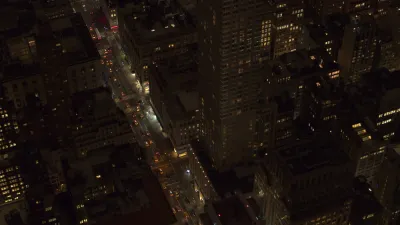The city that never sleeps depends on 396,572 street lights. As bright white LEDs replace the familiar amber glow, what does tomorrow (night) hold?

New York’s nightscape is as iconic (think film noir street corners and neon glitterati escapades) as it is taken for granted. A city without streetlights is impossible to imagine, but New York’s 396,572 street-side luminaires are as unremarkable as the streets’ paving — invisible until something changes. An initiative to replace sodium and halogen bulbs with energy- and cost-efficient LEDs has thrown the nightscape suddenly into question, as some city residents bemoan the loss of romance (and sleep). Nocturnal animals, too, are finding the conversion hard to take. But the iconic and under-appreciated nighttime infrastructure is also essential to the modern city. In New York, “nightlife” generates 300,000 jobs and $10 billion annually, and the recent establishment of an Office of Nightlife and the appointment of a new “night mayor” signals intention to give after-dark the same consideration as the daily grind. LEDs could be a boon for that industry, and for others who prefer to stay out late. SWA’s innovation lab, xl studied New York’s LED conversion for its impacts on the “Urban Sensorium”; below, Emily Schlickman explains what’s going on, what’s to come, and what it all could mean for the night and its many inhabitants.
FULL STORY: Illuminated Futures

National Parks Layoffs Will Cause Communities to Lose Billions
Thousands of essential park workers were laid off this week, just before the busy spring break season.

Retro-silient?: America’s First “Eco-burb,” The Woodlands Turns 50
A master-planned community north of Houston offers lessons on green infrastructure and resilient design, but falls short of its founder’s lofty affordability and walkability goals.

Delivering for America Plan Will Downgrade Mail Service in at Least 49.5 Percent of Zip Codes
Republican and Democrat lawmakers criticize the plan for its disproportionate negative impact on rural communities.

Test News Post 1
This is a summary

Test News Headline 46
Test for the image on the front page.

Balancing Bombs and Butterflies: How the National Guard Protects a Rare Species
The National Guard at Fort Indiantown Gap uses GIS technology and land management strategies to balance military training with conservation efforts, ensuring the survival of the rare eastern regal fritillary butterfly.
Urban Design for Planners 1: Software Tools
This six-course series explores essential urban design concepts using open source software and equips planners with the tools they need to participate fully in the urban design process.
Planning for Universal Design
Learn the tools for implementing Universal Design in planning regulations.
EMC Planning Group, Inc.
Planetizen
Planetizen
Mpact (formerly Rail~Volution)
Great Falls Development Authority, Inc.
HUDs Office of Policy Development and Research
NYU Wagner Graduate School of Public Service




























